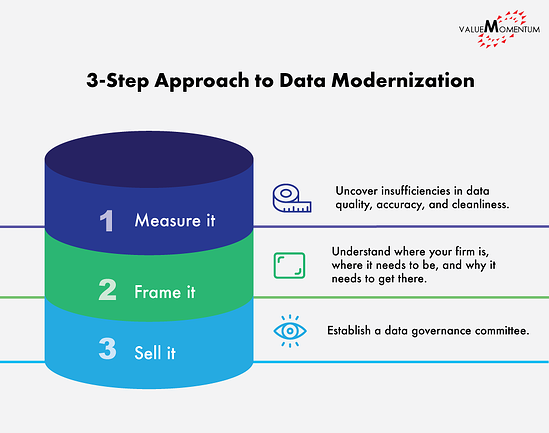More so than ever, business success depends on the ability to anticipate and rapidly adapt to market changes. Across industries, data modernization has become key to unlocking the intelligent insights necessary for strategic decision making. With agility now a key differentiator in the digital marketplace, it’s no surprise to hear that 84% of surveyed companies reported that they are already undergoing, or have already undergone, a data modernization.
The same trend holds true for the insurance industry, with many leading insurers embracing the move from a legacy to modern data infrastructure. If you’re an insurer who is looking to undergo an enterprise-wide data modernization, it is helpful to not only develop a robust data modernization roadmap, but also to learn from the real-life example of other carriers.
In the case of Pekin Insurance, establishing a Hadoop-based data mart and transferring 1.5 billion records from their legacy mainframe onto the platform enabled the carrier to eliminate a 5-year reporting backlog and unlock policy and claims data dating back to 1996. How did Pekin successfully pull off their data modernization initiative? Let’s take a closer look.
Pekin’s 3-Step Approach to Data Modernization in Insurance
According to Kim Wienzierl—Pekin’s Assistant VP of IT Data, Infrastructure, and Delivery—Pekin took a 3-step approach to overcoming the challenges of data modernization in insurance. A much simplified outline of Pekin’s actual journey, these 3 steps summarize the basic approach that brought Pekin to success.

Measure It.
Before Pekin could modernize or make improvements, the carrier needed to understand its current state. For this particular initiative, this required measuring existing data quality and data management maturity level. Undergoing this first step is essential for uncovering the insufficiencies the enterprise was facing, which included inadequate quality, accuracy, accessibility, and cleanliness.
Frame It.
The next step was framing the situation in a manner that gave the business a clear understanding of where Pekin was, where it needed to be, and why it needed to get there. Key questions to answer in this step included:
- How do we know that “now” is the right time for data modernization?
- What resources will we need to invest in, and what is the cost?
- What specific examples of ROI can we expect?
- How long will it take to achieve our goals?
Furthermore, because a truly modernized data approach is an ever-evolving initiative, it was also critical that Pekin put a strategy in place to measure and communicate success in a way that kept the organization excited and engaged by the new data platform.
Sell It.
As there was a culture of malaise surrounding data quality and access at Pekin, the carrier formed a Data Governance Committee. Comprised of two individuals from each of Pekin’s 14 functional areas, the Committee spent the first six months learning about data management, data quality, and data governance. Committee members also identified data requirements for their areas. Then, to champion the modernization, the Committee developed and executed a comprehensive education and marketing program, which is still ongoing as of 2020.
Components of Pekin’s Winning Data Modernization Strategy
Within each of the 3 steps discussed above are key initiatives that Pekin implemented as part of their data strategy. These initiatives are not unique to any given step; thus, insurers should self-assess their data needs and incorporate these initiatives into their data strategy accordingly.
The key initiatives, and how they played out in Pekin’s journey, are as follows:
- Determining Where to Gain Talent. Pekin focused on both forming a strategic IT partnership with an
experienced industry-focused solution provider, as well as attracting new data-savvy employees. - Developing a Data Management Framework. For each piece of data, Pekin determined corporate elements that needed to be fulfilled, such as policies, standards, security controls and audits, and then constructed a framework for addressing them.
- Creating an Elevator Pitch. Compressing the complexities of data modernization into a concise statement of truth, along with a brief statement of purpose, enabled Pekin to refocus its legacy culture. Pekin’s truth is – Better Data, Better Access…Better Decisions.
- Constructing a Business Capabilities Roadmap. Pekin visualized deliverables by placing them on a viewable timeline, which was included in presentations, open forums, and any other engagement-building activities.
- Mapping Out the Enterprise Data Model. Using universal data models that they obtained from its data modeling software supplier, Pekin developed a detailed enterprise diagram that not only showed what data was used by whom, but also the connections that existed throughout the enterprise. Depicting such interconnections helped break down silos, allowing all business users to see how their data needs relate to the data needs of others.
- Establishing a Data Architecture Blueprint. This is a visual reference for all of the technology components, hardware and software that comprise Pekin’s new data platform. It includes the internal and external sources of data, as well as the systems that utilize data, such as Pekin’s core Guidewire suite.
For details on how Pekin implemented these initiatives as part of their data modernization journey, check out our webinar – A P/C Insurance Data Modernization Journey.
